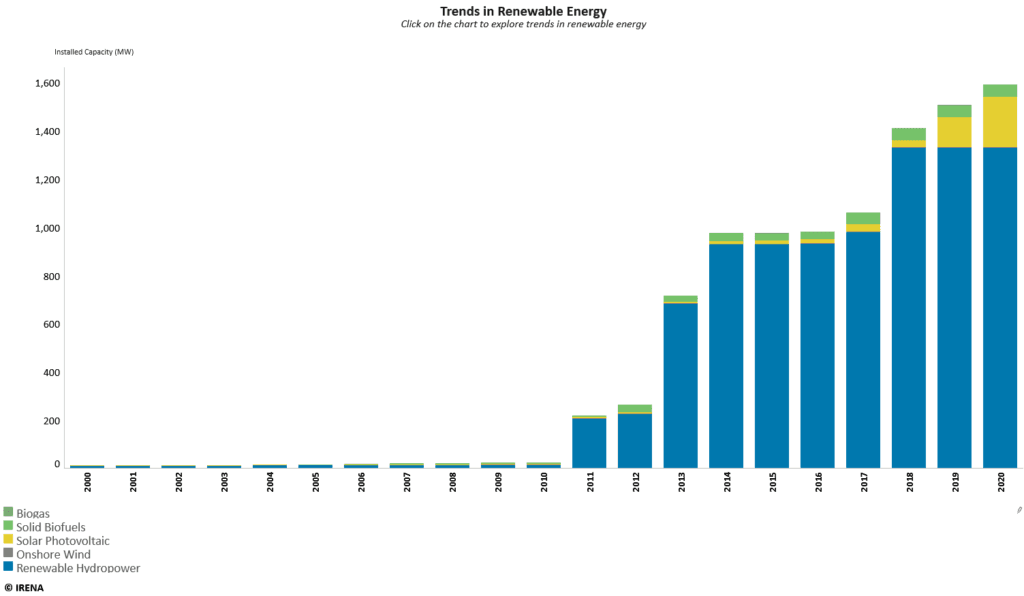Cambodia is making significant strides in integrating renewable energy into construction projects, driving both economic and environmental benefits. With 52.93% of the nation’s electricity coming from renewable sources as of 2024, the country is demonstrating a strong commitment to sustainable development. This transition is essential, especially as Cambodia’s power demand grows at a rate of 16% annually. By prioritizing clean energy technologies, Cambodia Renewable Energy in Construction not only meets rising energy demands but also positions itself as a regional leader in sustainable construction.

The Role of Cambodia Renewable Energy in Construction
Renewable energy is a cornerstone of Cambodia’s efforts to modernize its construction industry. Hydropower and solar power lead the country’s renewable energy portfolio, offering cleaner and more sustainable alternatives to fossil fuels. According to the Power Development Master Plan 2022-2040, Cambodia aims to achieve a renewable energy mix by 2030 with 27.7% from hydropower and 17.9% from solar energy. Notably, the government has opted against new coal-fired power plants or large-scale dams on the Mekong River, highlighting its dedication to eco-conscious policies.
Solar energy, in particular, has seen exponential growth. In just five years, its contribution to Cambodia’s national energy generation increased from less than 1% to approximately 400 MW. This significant growth underscores the viability of solar energy for powering large-scale construction projects, reducing dependency on traditional energy sources, and minimizing the environmental impact of development.
The Adoption of Renewable Energy Technologies
Cambodia’s adoption of renewable energy technologies is shaping the construction industry in transformative ways. Solar energy is a major focus of these efforts, with ambitious expansion plans in place. By 2020, the Cambodian government aimed to generate 15% of its energy from solar and is continuing to push for further growth. Projections suggest a 20% increase in solar energy investments over the next three years, driven by both public and private sector involvement.
Private investment is critical in bridging funding gaps for renewable energy projects. Developers like Schnei Tec Renewable Co., Ltd. are leading the way, with their 60 MW solar power plant achieving a highly competitive tariff of $0.03877 per kWh. This cost is significantly lower than the national average electricity cost of $0.083 per kWh, proving that renewable energy is not only environmentally sustainable but also financially advantageous.
Impact on Costs and Sustainability Goals of Cambodia Renewable Energy in Construction
The integration of Cambodia Renewable Energy in Construction directly impacts project costs and aligns with Cambodia’s broader sustainability goals. The financial benefits of renewable energy, particularly solar power, are evident in the reduced cost of electricity. Lower energy costs free up resources for construction developers, enabling more efficient project execution.
Beyond cost savings, renewable energy enhances Cambodia’s energy security by reducing reliance on imported electricity. In 2019, imported electricity accounted for 25% of Cambodia’s total power needs. By scaling up local renewable energy production, the country mitigates this dependency and strengthens its energy independence. Such measures are essential for long-term economic resilience and stability.
Furthermore, Cambodia Renewable Energy in Construction strategy supports its global commitments to sustainable development. By expanding solar and hydropower capacity, the country ensures access to clean, affordable, and reliable electricity for businesses and households. This approach aligns with the United Nations’ Sustainable Development Goals (SDGs), particularly those related to affordable energy, climate action, and sustainable cities.
The Future of Cambodia Renewable Energy in Construction
Cambodia’s renewable energy transition is paving the way for a greener construction industry. By integrating renewable energy technologies, the sector benefits from reduced costs, enhanced energy security, and alignment with sustainability objectives. The rapid growth of solar energy, coupled with competitive tariffs, demonstrates the potential for renewable energy to revolutionize construction practices.
Looking ahead, continued investment and supportive policies will be crucial in maintaining momentum of Cambodia Renewable Energy in Construction. The nation’s bold goals for renewable energy not only address immediate power needs but also lay the foundation for sustainable growth. The construction industry, as a key driver of economic development, stands to benefit immensely from this transition, serving as a model for other countries in the region.
